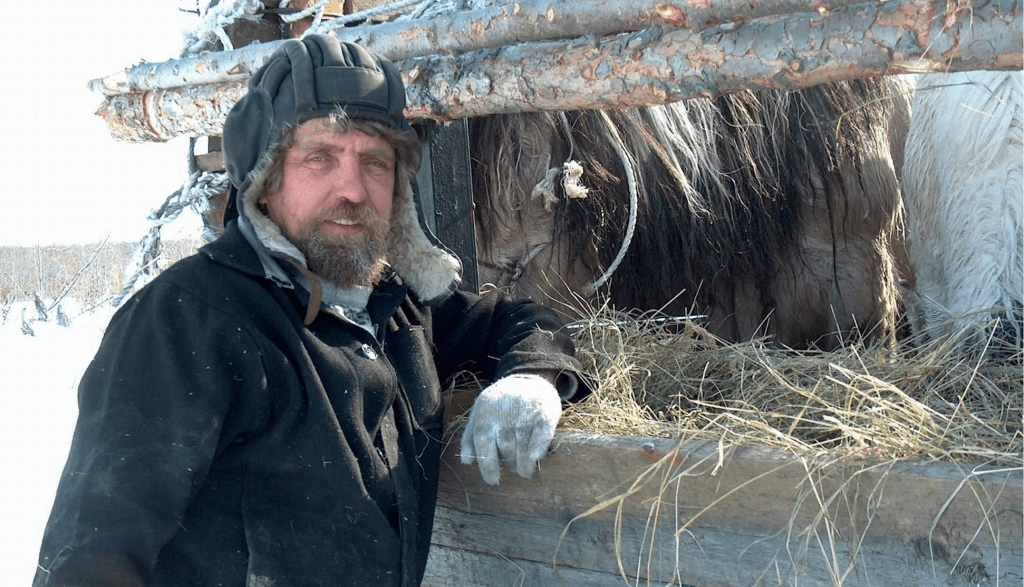
Take a tour of Pleistocene Park
in northeastern Siberia, where Russian ecologist Sergey Zimov and his son Nikita are studying how to rewild the Arctic. Introducing herbivores en masse to Siberia and northern Alaska, they believe, would bring back a lost biome—the mammoth steppe—and prevent permafrost from melting and releasing billions of tons of greenhouse gases into the atmosphere. — Science Magazine
The excellent Science Magazine article “Born to Rewild” by Eli Kintisch can be found here
This Wild Field Manifesto is a work in progress by Sergey Zimov
11/25/14
For hundreds of millions of years, terrestrial ecosystems were an arena of struggle between plants and herbivores. To avoid being eaten, plants protected themselves with thorns, tall heights, bitterness, acids, and sharp smells. Many developed numerous poisons: Solanaceae developed nicotine; poppy developed morphine; and willow developed aspirin. But, 20 million years ago, life on the planet changed. Grasses and quickly-growing pasture herbs appeared. They did not spend resources on thorns and poisons; their main strategy was rapid growth. All of them were tasty, nutritious, and not afraid of being eaten. Giving several harvests a year, these plants fed numerous big herbivores. What wasn’t eaten by “bulls” and “horses” was eaten by omnivorous “sheep” and “goats.” In this way, the evolutionally youngest ecosystems were formed – pasture ecosystems.
Like in economics, in ecology the rate of the capita turnover is important. According to the V.I. Vernadskiy law, evolutional processes are directed towards increasing the turnover of biological elements. For instance, in the evolutionally relict spruce forest, bio-cycling is slow and green leaves live for ten years. This biomass is barely edible and decomposes slowly on the soil surface. In contrast, grasses in pastures live only few weeks on average. In the warm stomachs of herbivores, they decompose in just one day and their main ecosystem capital (nitrogen, phosphorus, and potassium) is quickly returned into the soil, and eventually into new leaves. These rapidly growing grasses needed abundant mineral supplies, which herbivores themselves maintained. Abundant herbivores managed and extended their pasture ecosystems themselves. Moss and lichens were trampled. Goats and roes ate the young trees and shrubs seedlings. Bison and deer killed trees by eating the bark. Elephants and mammoths simply broke trees. Through fertilizing, harvesting, and trampling, herbivores managed their pastures in any climate.
Fifteen thousand years ago, pasture ecosystems were at the peak of their evolution. They occupied most of our planet. Forests at that time were preserved only in places with poor stony or sandy soils. Even in the Amazon, only few islands of forest were left. At the time, the biomass of big herbivores on the planet reached 1.6 billion tons.
All pasture ecosystems had a similar assemblage of ecological “professions,” with all animals giving profit to their ecosystem. “Bulls” and “horses” (buffalo, gnu, bison, zebra, horses) maintained the bulk of the pasture bio-cycling. Omnivorous “goats” and “sheep” fought with weeds. In the north, horses and reindeer trampled snow, helping bulls, sheep and saiga to survive during severe winters. Gophers and boars loosened soil. Elephants (mammoths) broke trees and dug depressions in the beds of the drying streams, supporting the net of the public ponds. Predators evenly spread herbivores along pastures and maintained their optimal numbers. “Big cats” regulated density of “wolves”.
Even in areas forgotten by nature, animal density remained very high. During the ice age, Northern Siberia accumulated thick layer of loess sediments. These are the soils of the mammoth steppe. By counting bones in these frozen sediments, it is possible to accurately estimate the density of animals in this ecosystem. On each square kilometer of pastures lived 1 mammoth, 5 bison, 8 horses, 15 reindeer. Additionally, more rare musk ox, elks, wooly rhinoceros, saiga, snow sheep, and moose were present. Wolves, cave lions and wolverines occupied the landscape as predators. In total, over 10 tons of animals lived on each square kilometer of pasture- hundreds of times higher than modern animal densities in the mossy northern landscape.
As stated by V.I. Vernadskiy, the law of “life pressure” states that, in “full value” ecosystems, all resources must be consumed. Leaves should be abundant enough to either evaporate all available water or, in a wet climate, absorb all sunlight. Everything that grows must be quickly recycled. On fertilized soils, even in the Arctic coast, the regular grass harvest is over 100 tons per km2. In Europe common harvests are hundreds of tons per km2. The amount of forage required for herbivores is easy to estimate using a mass ratio of 10:1. If, for instance, grasses give a 500 ton/km2 harvest, then this pasture can be maintained by 50 tons of herbivores, which is 100 cows or 1000 sheep – a common animal density on rich domestic pastures. 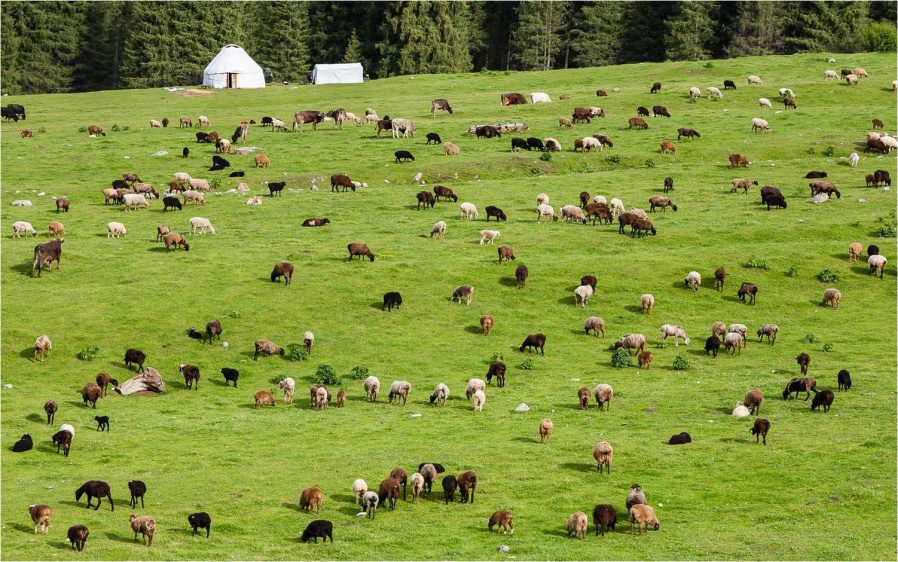
Density of wild animals was no less than on the domestic pastures.
Wild animals use resources more efficiently than their domestic counterparts, thus to maintain wild pastures there must be no fewer animals. In a well-balanced ecosystem, the number of animals born and eaten by predators should be equal. Among the warm-blooded animals, the typical ratio between herbivores and predators is 100 to 1. This means that a reach pasture ecosystem in the past supported a half ton of predators. This could be a pair of lions or tigers with kids, a pair of cheetahs, a wolf family plus foxes, wolverines, griffins and ravens.
In the rich pasture ecosystems predators had no need to seek prey- they simultaneously saw hundreds of herbivores and few contestants. Therefore, their main goal was to have their own territory. These ecosystems must have had complicated social hierarchy. Predators spent most of their energy not on hunting but on protecting territory and their herbivores. Settled herbivores, in turn, knew their predatory “master” and his territory and “understood” that, if they are healthy and not running on a stranger’s land, their master would not hunt them and, in contrast, would probably protect them from other predators. Predators tried to kill as many migrating animals as possible – if they didn’t do it, their competitors would. Stealing from enemies and competitors was also profitable. Predators tried to maintain their best producers from herds, their main capital, for as long as possible. This simple strategy was invented not by wolves and tigers. Some ants had already known how to pasture and protect herds of aphids– their “dairy cows”– for 200 million years. In fact, domestication first took place when all creatures on the planet were still unicellular. In every cell of our body, very useful mitochondrion live and are passed as a “dowry” from mothers to daughters.
Several million years ago, our ancestors climbed down from trees and moved into the pasture ecosystems. It is in these ecosystems Homo sapiens appeared and spread. Pasture ecosystems were the most food-rich ecosystems, but at the same time they were the most dangerous. In the open landscape with low-growing vegetation, it was hard to find shelter. Wherever you were, hundreds of pairs of eyes saw you. All the big herbivores had ways to both protect themselves and attack, and all of them were 2-3 times faster than humans. Every year wolf families birth 6-10 puppies who became hunters and parents themselves within a year. The loss of several wolf brethren during a hunt was not vital for the community; they could afford to take the risk. Humans, in contrast, have only one baby a year which can’t walk for a long period of time and has to manage to live for at least 15 years to become a getter. The price of risk between wolves and man differed by hundred times. Therefore for human family’s survival, even a small risk of the breadwinner’s death is unacceptable. How did humans and their kids survive surrounded by thousands of dangerous animals? Hunting was dangerous, and fighting the prey off the predators was even more dangerous. In these ecosystems everything was visible. If you hurt even a foal, you could earn enemies both in herbivore community and in the community of the predators. What did the first, not yet very skilled and armed, people eat? What was the human ecological “profession?” What profit did he give to the ecosystem?
Humans were wise, sly, and lived in united communities, but for survival that wasn’t sufficient. For survival of a species it is very crucial it has its own unique resource which no one could take from them. The human stomach is relatively weak, causing us to need high calorie food. On the frequently harvested pastures, seeds had little chance to ripen. Grass stems are too tough for us to digest. However, humans have a very strong liver. Humans are one of the few species which can eat onions, garlic, horseradish, black radish, sorrel, etc. All of these were considered very dangerous pasture weeds. Few animals could eat them and they can overtake other grasses leaving bulls, horses, and other herbivores without forage. However, all of these plants are high calorie products (onion has a record high sugar content of up to 20%). Goats can eat even the most poisonous plants, but they only have access to leaves. Human, in contrary, can dig to the roots. We can eat onion and garlic raw, but after the invention of fire these roots “became sweet”. Additionally, these edible roots preserve well and humans could store them.
Another resource accessible only to humans was fat-rich marrow from big herbivore bones and skulls. Those bones were too tough for big cats and wolves, but humans could crack them open with one hit. All that was required to obtain this resource was to sit in a safe place and keep an eye out for griffons and ravens, who would tell you precisely where an animal died from a few kilometers distance. After the dangerous predators left, humans simply had to collect the gnawed bones and bring them to their camp, where they could crack, cook, and eat them in safety. With the herbivore density being tens of tons per square kilometer, herbivores died every day within the radius of visibility, allowing human families to sustain solely on marrow with onions and horseradish. For these food sources, humans did not have much competition aside from other humans.
For many hundreds of thousands of years, humans in pasture ecosystems were the “cleaners” and last order scavengers. They gave profit to the ecosystem, so other animals could stand humans. However, it is unlikely that humans were a respected creature. Smelling of smoke, onion, and garlic and dressed in rags taken from dead animals, humans weren’t the most desired prey. Humans may have been the wisest species in this ecosystem, but they were on the bottom of the social pyramid, lower then goats and hyenas. Even the dumbest animals could butt or kick him. Under this social status humans could not be zealous master; they rarely ate enough and their strategy for survival was simple – the more you can manage to procure the better. However, with time
Abundant herbivores managed and extended their pasture ecosystems themselves … Through fertilizing, harvesting, and trampling, herbivores managed their pastures in any climate.
their knowledge grew and weapons developed. At some point, humans started to hunt even the big animals and take away prey from predators. Twenty-five thousand years ago even mammoths became frequent food for humans. Finally, humans had evolved to the status of “top predator.” They had become competitors for predators and an enemy for herbivores. Human social status had changed and animals began to fear them, but humans did not become “king of the animals” and zealous master. Formed after long evolution and fixed in the genome, human’s insatiable plebeian character changed little. Some of the culinary preferences did not change much either – onion is still one of the most consumed product on the planet.
Fourteen and a half thousand years ago, sharp climate warming took place. The Ice Age was over. Human chances for survival, especially for kids, substantially increased in the middle and high latitudes. People populated north of Eurasia and then penetrated into America. Experienced and well-armed hunters met herds of untamed animals. The further humans moved from their historical motherland, the more they engaged in their “bloodthirsty pursuit.” In northern Asia, 8 megafauna species went extinct upon human arrival, in North America, 33, and in South America almost all – 50 species in total. As hunting and technology developed and animal density on the pastures declined, the animal density in most regions became insufficient to maintain pastures. As a result, forest and tundra (shrubs, trees, moss) began to press pastures, causing forest area in the world to increase ten-fold.
The human-hunter had caused his own food source to vanish. Animal density sharply decreased and, for survival, humans had to learn how to become zealous masters. People domesticated many animals and learned how to pasture and protect their herds. Species which had masters before were easy to re-domesticate.
People have co-existed with dogs (wolves) for a long time. Good shepherd dogs don’t need to be taught how to pasture and protect animals – they have it in genes. Dog’s ancestors could do that, but people had to learn how to do it, so it is a question who was teaching whom how to pasture animals?
When wild animals became sparse, grasses on the meadows and steppes began to give fruitful harvests of tasty seeds. People used this new possibility and learned how to make artificial grain pastures. They learned how to treat grasses, plow, and sow. Wheat, rice, barley, sorghum, corn, sugar cane are all grasses taken from wild pasture ecosystems. Humans had destroyed their motherland ecosystem and, to survive, had to learn how to treat their own land and animals to create similar highly-productive pasture ecosystems.
While wild and domestic pasture ecosystems are relatives and need similar fertile soils, it is hard for these two ecosystems to co-exist on one territory. In the modern world agriculture won ubiquitously; all steppes, prairies, and almost all tropical grasslands are plowed or turned into domestic pasture. But it was long and hard battle. Wild meadows covered bread cropland with weed seeds. Hordes of rodents ate all the harvest, wild herds of herbivores trampled fields, and boars plowed gardens. Wild stallions, bulls and rams broke fences and stole domestic females. Eagles, kites, foxes, and polecats stole domestic birds. Lions, tigers and wolves, faced with losing their territory, stopped being zealous masters and turned into bandits, cutting the cattle of their enemies by entire herds.
In the past, human starvation was common. Every family had 8 to 10 kids. Each cupped hand of grain, each tiny plot of land, and each lamb was counted. Wild nature was a deadly enemy of people. Both farmers and stock-breeders profited from killing wild animals. When Russian peasant went to kill a bear with a bear spear, he was risking a lot, but he did it to earn meat and skin, become famous, and get somebody to like him. But, mainly, he did it to keep crops of oats on the fields, secure cows and sheep, and make sure that kids going to pick berries and mushrooms in the forest came back home alive.
Even big herbivores, who only have one calf a year, populate very rapidly. Population can increase 100-fold in 20 to 25 years. Predators reproduce even faster. It is not easy to win a battle against wild nature. A simple peasant could not spend much time fighting it –he did not have enough skills or resources for that war. It was the peasant’s masters who managed the wild. War was the main occupation for aristocrats, and war with wild nature was even more common than war with neighbors. Hunting wasn’t entertainment; killing hundreds of wild animals over one hunt kept animal populations low and did not allow hordes of animals to descend from mountains or move from barren forests into the farmers croplands. Aristocrats in medieval Europe kept armies of chasseurs, hounds, borzois, bulldogs, and cheetahs for hunting, but to kill a wild bull with a spear, even with a bunch of bulldogs hanging on it, was dangerous. Hunting was a respectful occupation. Not too long ago, hunters who killed thousands of animals in Africa were met in civilized Europe as heroes, as Olympic champions.
The last lion in Europe vanished in antique time; the last tigers and cheetahs vanished in medieval times. Even the wolf has persisted in only a few places. The last full-frame pasture ecosystem in Europe vanished in the beginning of the 17th century and was mentioned in the chronicles as the ecosystem of the Wild Field. Farmers and nomads had been in an instant war and, between their lands, there was a boundary stripe. At that time, the most expensive good was slaves and to enter this territory was dangerous for everybody. On this neutral steppe-forest zone survived numerous herds of wild bulls – aurochs, bison, tarpans, onager, red deer, roes, reindeers, moose, boars, and saiga. However, during the Mikhail Romanov reign nomads were pressed south and this rich section of wild field was plowed.
Man had won pasture ecosystems ubiquitously. He occupied the land and wiped out or enslaved its inhabitants. Now, of those animals which roamed the grassy pastures, only those who managed to hide in the primeval forest, unreachable mountains, severe tundra, or dry desert survived.
In the modern view, all land overgrown by grasses is human property and wild animals are not welcome there. By law all fields and meadows are agricultural lands. Today most reserves and national parks on our planet, including ones in Africa, are based on the principle that we give to the wild that which we don’t want for ourselves. Usually they are hard-to-access territories with poor soils and complicated terrain where you can’t farm or raise cattle. It is in these regions the last wild herbivores survive. For us, that is the only “wild nature” we know, but even there animals can’t have freedom. If animal numbers grow, they start to influence the vegetation by destroying trees and shrubs. Cleaning the landscape for grasses and pastures is what animals are supposed to do, but people see it as a catastrophe. Our forests die! Nature dies! Some domestic animals: dogs, horses, and cows… try to come back to wild nature, but people treat those animals like deserters or traitors. Those animals are outside the law.
As in the international proletarian hymn “All world of violence we will destroy to the basement, and then we will make our own new world, who been nobody will become all,” the same happened to the planet’s environment. Former cleaners and scavengers became the main and only masters. The “political” changes in nature were big; the multi-species “military democracy” was transformed into a one-specie tyranny (proletariat dictatorship). However, the economical organization of nature did not change much. Agrocenosis – are similar rapidly cycling pasture ecosystems managed by a big predator, Man, who destroys forests and spreads grasses across the planet with fire, axes and tractors.
Currently, with the use of non-refundable resources, the biomass of our civilization (that is a weight of all humans, cows, sheep etc.) has reached 1.2 billion tons. But mineral resources are running low, soils become poor, the climate of the planet is changing, and biodiversity on the planet is dropping. In its current form, our civilization is unlikely to last long.
Without self-regulating ecosystems, life on the planet can’t be sustainable. Everybody understands that and, today, many people are willing to protect nature. However, in most people’s consciousness nature is a forest with harmless singing birds. It is of higher priority to preserve the richest, most precious ecosystems. Pasture ecosystems were the richest ecosystems. They are our relative, genetically close ecosystems from which we borrowed the plants and animals which are the basis of our civilization. It is hard to preserve the genetic variability of animals and plants in the freezers or zoos; this can only be done in ecosystems. Pasture ecosystems are not afraid of fires or chemical pollution and are able to quickly adapt to climatic changes.
Of all the wars humankind has fought in the past, the war with pasture ecosystems is the longest lasting one. But today it can and must be stopped. Somewhere in tropics there are still battles going on – animals and people still die. Farmers protecting their harvest from elephants dig defensive ditches and blow thousands of petards. But in Europe, Siberia and America there is no fear and hate towards wild animals anymore. The majority of people don’t even know about this war. It is there pasture ecosystems must be recreated.
Most of the species that once roamed in the pasture ecosystems have survived – some in the forests, some in deserts, some in the zoos, and some as domestic species. Other animals are proposed to be recreated through genetic engineering.
All that is required to recreate pasture ecosystems is to reliably fence off a territory where grasses and herbs grow. The second step is to collect all animals which can live on this territory. Once there, the animals will remember how to live with each other themselves. They will divide pastures and occupy all ecological niches according to their professions. It is their job to self- regulate density; the weak will die, the strong will re-populate, the ecosystem assemblage will stabilize and, then, will be ready to reintroduce into new territories. There is still enough space for pasture ecosystems on earth. Even in the highly populated country of Holland, in the Amsterdam suburb thousands of animals were given freedom. Even though the land there is poor compared with its surrounding, animal density is tens of tons on each square kilometer of pasture. And surrounding agricultural and urban lands do nothave any conflict with the pasture; only a trivial metal net fence and few inspectors securely separate the previously combatant sides. A similarly dense and numerous population of animals lives behind a fence, surrounded by croplands, near Edmonton in Canada.
Yes, our civilization owns almost 0.8 billion tons of cows, pigs, sheep, camels, etc.; but in the not too distant past animals in wild ecosystems were twice as abundant. These ecosystems were stable, did not fear climate change, and were utilizing only the sun’s energy.
The green revolution allowed humans to increase harvest from our fields by several times, but the energy input was increased by 3 orders. To plow, cut hay, transport grain, or mine for fertilizers we burn gas, oil and coal. As a result we have so much CO2 in the atmosphere and water in the oceans became so acidic that the carbonate skeletons of plankton, coral, and mollusks shells began to dissolve. The climate became unstable, the atmosphere warmed, and forest fires became more frequent. Insect pests “activated” with increased temperatures and millions of hectares of forest are dying. In the near future, planet ecosystems will change inevitably. The biggest changes will happen on the north. North Siberian plains and some regions of Alaska and Yukon Territory are covered with a stratum of mammoth steppe soils tens of meters thick. Huge ice wedges constitute half the volume in these sediments. These soils can be considered like a glacier, protected from summer thawing only with the heat insulating layer of modern soils. Because of climate warming these permafrost soils are already starting to thaw. As soon as the ice wedges melt, modern soils, vegetation, and everything that is on the surface collapses and slides downslope. This surface collapse can be on the order of many meters.
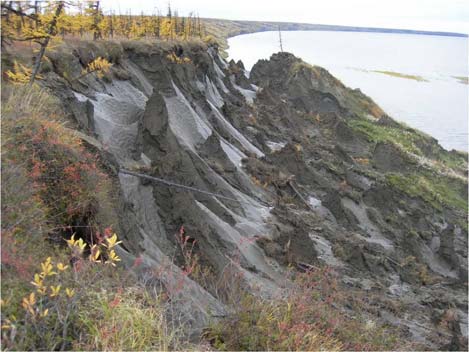
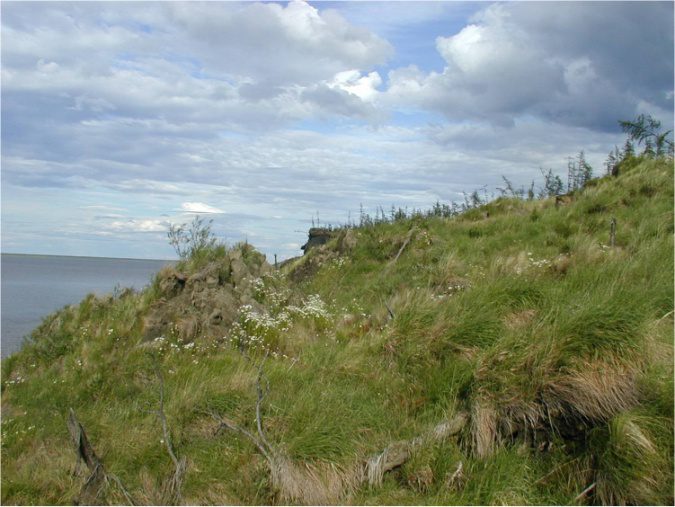
North Siberian lowlands are covered with the tens of meters layer of ice-rich soils of the mammoth steppe. At permafrost degradation these fertile soils are quickly getting overgrown by grasses.
Frozen soils of the mammoth steppe contain lots of organic carbon – three times more than all tropical forests of the planet. When these soils thaw, microbes which were previously frozen there for millennia wake up and immediately start to decompose the soil organics, producing the greenhouse gases – CO2 and methane. If current climate change continues, then in the not too distant future the thawing soils of the mammoth steppe will be the biggest natural source of greenhouse gases on the planet. This will cause additional warming to the climate and permafrost will thaw even quicker. We cannot artificially stop this process. However, pasture ecosystems can. Where permafrost begins to degrade, fertile mammoth steppe soils appear on the surface and are very quickly overgrown by grasses. The grass roots “armor” and dry mobile soils, preventing further erosion. Permafrost degradation can promote the appearance of pastures which can feed millions of herbivores. In the winter soils in the north are covered with snow, which is a good heat insulator. Outside air temperatures can drop to -40-500C, but soils under snow can be only -100C. Animals in pastures, looking for food, excavate and trample all snow several times each season, causing it to condense and lose its heat-insulating abilities. Therefore the introduction of animals on pastures cools permafrost temperatures by 40C, which can stop or substantially slow down permafrost degradation.
Forest and shrublands are dark year round and absorb the sun’s heat well. Pastures are much lighter and, in the winter, are white if they are covered with snow. Therefore pastures reflect more of the sun’s heat and cool the climate.
It is very hard to agree to reduce industrial CO2 emissions. Reducing permafrost emissions are much easier. All is needed is to cross mental barriers, accept that pasture ecosystems have a right for living and freedom, and return part of the territory which our ancestors took from them. Giving back territories we don’t use ourselves would be sufficient. 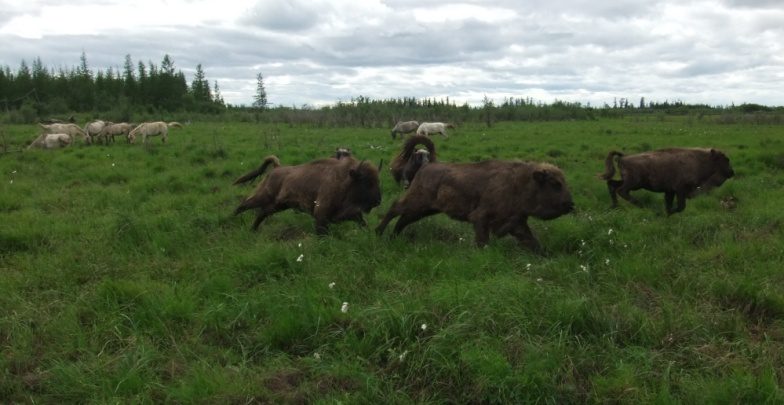
Kolyma river lowland, 150 km away from the Arctic coast. On the Pleistocene Park pastures, horses, bison and musk ox have met again and maintain their pastures together.
Russia is the biggest country. Not too long ago, this territory was dominated by mammoth steppe and animal numbers reached up to a billion. Now, the wild animal density is a thousand time less. Even if animals are somewhere near humans, they are afraid of us to death and try not to be seen.
Expenses to treat land and collect harvest are same in Russia as in Europe, but rains are less frequent and climate is more severe. Therefore, harvests are 2-3 time lower and it is much harder to compete on the international food market. Currently, in Russia, tens of millions of hectares of cropland are no longer being used for farming. Even in the fruitful forest-steppe zone, portions of land are abandoned and fields are now getting overgrown by tall weeds and forest. Most of these territories can be transformed into highly productive pasture ecosystems. All species of vegetation and animals once inhabiting Wild Field are still present. On these lands, without additional feed or control, millions of animals can freely live, serving as both a genetic bank and a food reserve. Bio-cycling on the field will increase, and soils left poor after over- treatment will, again, start to accumulate humus. If required, the animals can be moved to newly attenuated fields and the rich pastures can be turned into fertile cropland.
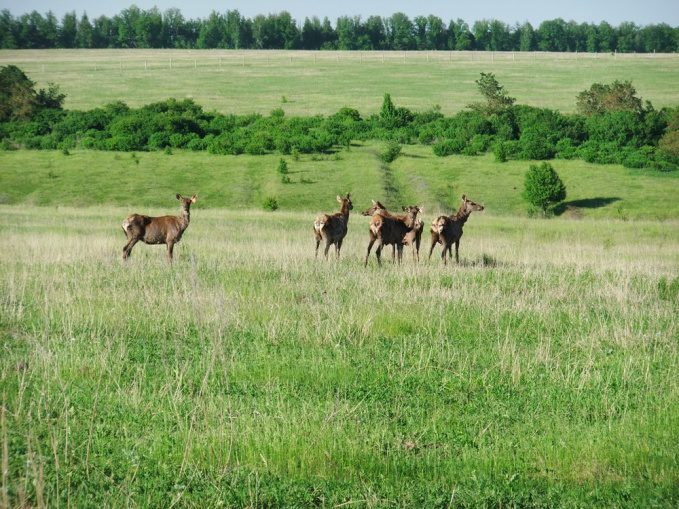
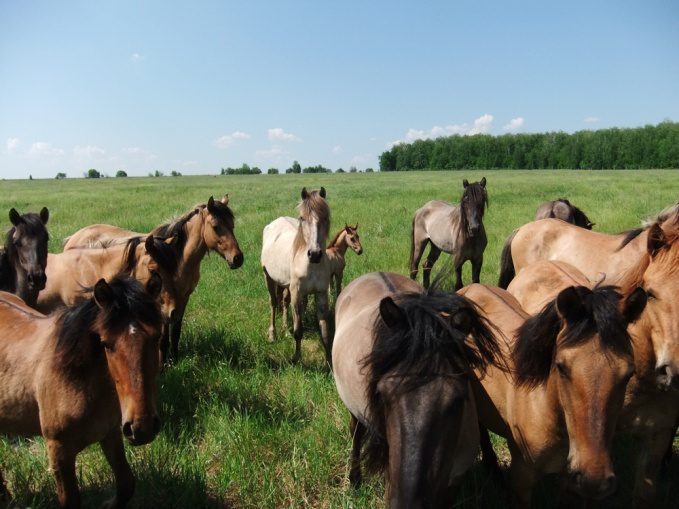
The historical area Wild Field (250km south of Moscow). Former animals which inhabited this place centuries ago are coming back.
In the Wild Field animal density must be higher than in the sun-burned reserves of Africa. Millions of people fly to Africa to see animals that are not in cages, but in the wild. Similarly, Wild Field can be visited by train on the weekend. It is important to show our kids real wild nature- the nature of their ancestors.
We don’t have a gene of zealous masters of Earth, this, same with many other things we have to learn.



